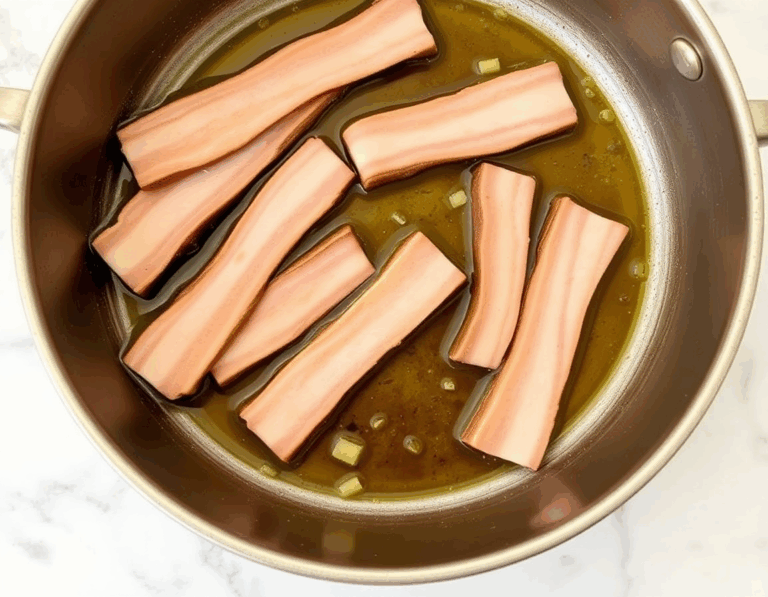Oh, the simplicity of pasta dishes never ceases to amaze me, and Pasta Alla Gricia is no exception—it’s like a symphony of flavors with only a handful of ingredients. Just imagine the aroma of sizzling guanciale filling your kitchen as you prepare this timeless Roman classic. Recently, I tried it with a sprinkle of fresh black pepper, and let me tell you, it’s an absolute game-changer—if pasta could talk, it’d sing operas about this dish!
Steps
- Prepare the Guanciale: Partially freeze the guanciale for easier slicing, then cut it into 1/4-inch thick batons. Heat some olive oil in a large skillet over medium-low heat, add the guanciale, and cook until the fat renders and the pieces are crispy. Remove the cooked guanciale from the skillet, leaving the rendered fat behind.
- Bloom the Pepper: Reduce the skillet heat to low and add freshly ground black pepper to the rendered guanciale fat. Stir the pepper until it foams and releases its aroma, then remove the skillet from heat.
- Cook the Pasta Partially: Bring a pot of salted water to a boil and add the rigatoni. Cook the pasta for about 5 minutes until it is halfway done, then reserve two cups of the pasta water and drain the pasta.
- Finish Cooking the Pasta: Return the skillet with the guanciale fat and pepper to high heat. Add the reserved pasta water and bring it to a rapid boil. Add the partially cooked pasta to the skillet and continue cooking, constantly stirring, until the pasta is al dente and the sauce thickens.
- Incorporate the Guanciale and Cheese: Add the guanciale back to the skillet and toss to combine. Remove from heat and mix in half of the finely grated Pecorino Romano until fully incorporated. Add the remaining cheese, toss again, and adjust the sauce consistency with more pasta water if needed. Serve immediately with additional cheese on the side.
Ingredients
- 8 ounces (225 g) guanciale (cured pork jowl), in a single piece
- 1 tablespoon (15 ml) extra-virgin olive oil
- Kosher salt
- Freshly ground black pepper (about 1 teaspoon)
- 12 ounces (340 g) rigatoni pasta
- 2 ounces (60 g) finely grated Pecorino Romano cheese, with extra for serving
- 3 quarts of water for boiling pasta
- 2 teaspoons kosher salt for pasta water
- 2 cups (475 ml) of reserved starchy pasta water
FAQ
- What is Pasta alla Gricia?
- Pasta alla Gricia is a classic Roman dish often referred to as “white amatriciana” or “carbonara without eggs.” It’s a simple yet flavorful pasta made with guanciale (cured pork jowl), black pepper, Pecorino Romano cheese, and pasta water to create a rich, emulsified sauce.
- Can I substitute pancetta for guanciale in Pasta alla Gricia?
- While pancetta and guanciale are both cured pork products, they have distinct flavors. Guanciale offers a bolder taste, which is key to authentic Pasta alla Gricia. However, if guanciale is unavailable, pancetta can be used, though it won’t provide the same depth of flavor.
- What type of pasta is best for Pasta alla Gricia?
- Rigatoni is often recommended for Pasta alla Gricia because its ridges and tubular shape are perfect for holding the sauce and crispy guanciale pieces. High-quality pasta with a rough texture is preferred for better sauce adhesion.
- Why is Pecorino Romano cheese important in this recipe?
- Pecorino Romano is a vital ingredient in Pasta alla Gricia, providing a salty, tangy flavor that complements the guanciale and black pepper. It’s important to use genuine Pecorino Romano, made from sheep’s milk in specified Italian regions, to achieve the authentic taste.
- How should I cook the pasta for Pasta alla Gricia?
- The pasta should be cooked halfway in a small amount of salted water to create starchy pasta water, which is essential for emulsifying the sauce. The pasta then finishes cooking in the skillet with the sauce, allowing it to absorb flavors and reach the perfect al dente texture.
Tips
- Freeze Before Slicing: Partially freeze the guanciale for 15 to 45 minutes before slicing. This makes it easier to cut into even batons, ensuring uniform cooking and texture in the final dish.
- Use Quality Ingredients: Opt for high-quality dried pasta, preferably one that is extruded through a traditional bronze die, to achieve a rough texture that holds the sauce better. Also, ensure you’re using authentic Pecorino Romano cheese for the best flavor.
- Control Sauce Consistency: If the sauce reduces too much before the pasta is al dente, gradually add reserved pasta water in small increments. This helps maintain the right consistency for a perfectly emulsified sauce.
- Finish Off-Heat: Once the pasta is cooked, remove the skillet from heat before adding Pecorino Romano cheese. Add the cheese in stages, tossing well to prevent clumping and ensure a smooth, creamy sauce.
Equipment
- Stainless Steel Skillet: A large 12-inch skillet for cooking the guanciale and emulsifying the sauce.
- Chef’s Knife: For slicing the guanciale into lardons.
- Microplane Grater: For finely grating Pecorino Romano cheese.
- Liquid Measuring Cup: To measure and transfer the starchy pasta water accurately.
- Colander: For draining the pasta while reserving the pasta water.
- Rubber Spatula: For stirring the pasta gently to ensure even cooking and sauce emulsification.

